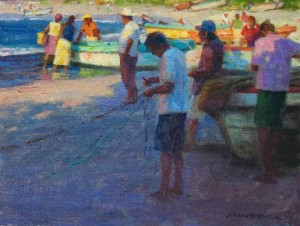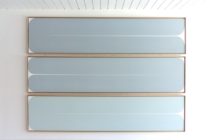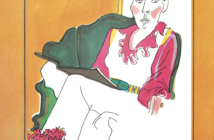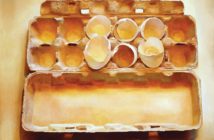Dear Artist,
Yesterday, my friend Chuck Putnins, whose other life is anesthesiology, wrote, “Next year I’ll be taking 6 months off work from May 1 to November 1. During that time I want to get better at painting and develop my own style. How do I best do this? I realize that the simple answer is ‘just paint Chuck,’ but I’m afraid of wasting a lot of time without some kind of structure. A plan is what is needed. Any ideas? I want to get the most out of my time off.”

Untitled (Your Body is a Battleground), 1989
Photographic silkscreen on vinyl
112 x 112 inches
by Barbara Kruger (b. 1945)
As well as being an accomplished visual artist, Kruger has had a distinguished career as Head Designer at Condé Nast, wrote columns for Artforum and taught at U.C. Berkeley.
I like this question. You know that I’ve got a system for anyone with a week, a month, or even for the big sabbatical at the end.
Think of putting a stew on a stove. You are going to live on this stew for the duration of your sabbatical. Every day you will take from it — and every day you will add to it. Sometimes your stew will be a “watched pot.” At other times it will be best left to bubble on its own. It will last from the minute of your beginning, to the minute of your finishing — always in a state of transformation and change.
You ought to structure your sabbatical by keeping notes of what’s going in and out of your pot. There will be surprises. Boiling over and boiling dry will be hazards. Sometimes you will have to refer to cookbooks. You’ll have to stack your cupboards. Clinging to the linear nature of your exercise, you’ll never loose sight of your cookery, and like a genie, your own true muse will arise from it. She will not bore you. The aroma of your concoction and the sense of discovery will have you up every morning, eager for the continued joy of the process, and it will keep you from the shallow temptations of the bars and dance halls.
Chuck, this is between you and me: There are those who will think I’m beginning to lose it. Pay no attention to them. I know you, and I know you can do it. You have imagination and ready ideas. Those that can’t stand the heat have to get out of the kitchen. Not you. You are going to love every minute. Also, for you it will be a nice change from needling people.
Best regards,
Robert

Untitled (How come only the unborn have the right to life?), 1982
Mixed media photograph and type on paper
8.75 x 5.88 inches
by Barbara Kruger
PS: “Paintings come out of themselves.” (Lawren Harris) “Every artist who evolves a style does so from illusive elements that inhabit his or her visual storehouse.” (Mary Carroll Nelson)
Esoterica: Commitment to projects can be reinforced by keeping a journal. “Weblogs,” or “Blogs” are online journals that proclaim a commitment to everyone out there. The intimate minutiae of progress can make surprisingly good reading, as well as satisfying narcissistic and exhibitionistic tendencies. “Blogging” is also used for building support groups, both spiritual and green.
This letter was originally published as “Sabbatical” on August 15, 2003.
“Although my art work was heavily informed by my design work on a formal and visual level, as regards meaning and content the two practices parted ways.” (Barbara Kruger)
Featured Workshop
Featured Artist
I was trained to become an Illustrator and did Illustration work for over 25 years. That experience gave me the discipline and skills to do a wide variety of subjects and in different mediums. Because of that I have been honored to be a “Designated Master” with both the American impressionist Society and the Oil Painters of America. I consider myself a “Traditional/Impressionist” and have worked hard to strive to keep my standards up and make a good work of art. As I tell my students..”an accomplished painting has an interesting and beautiful arrangement of shapes and colors”. That is what I strive to do, regardless of subject matter; to make a decent “work of Art”. I also have always loved to travel and am fascinated by different peoples and their cultures along with all of the beautiful and interesting landscapes that are part of this wonderful world that we live in. I feel very fortunate that I get to do what I really love to do.







25 Comments
I love this “stew on the stove” analogy for getting the most out of a painting or artistic practice to developing one’s work. I put my painting stew pot on the back of the stove for good in 2010. Before that, it was a scattering of one pot wonders that were tasty but didn’t have that long, satisfying , nourishment which comes with the consistency of regularly tending to a stew over many months or years. If it begins to feel repetitive, add some new spice or herb or seasonal garden vegetable that you hadn’t thought of trying. Even throw in some fruit maybe. Invite other stew lovers over and receive fresh appreciation for your culinary practices. But whatever you do, I am absolutely certain your artistic drive will not go hungry. Happy stew tending!
I once had the opportunity to spend a period of time focusing only on painting. I made sure all my tools stayed out. I didn’t want to waste time taking out and putting away. It is too easy to clean house or do the laundry or gardening and say “I’ll get to it this afternoon.”
The first, and most important thing, is to to turn off your phone. Let the answer machine or voicemail get it. you can check in when you have finished for the day. I put a note on my front door. “I am working, please come back after dinner.” Now I have removed all those things that would distract or interrupt.
If the canvas on the easel is pristine, scrub a few colors onto it. It doesn’t matter what. This is just to get you going. The greatest setbacks for artists are procrastination and the fear of failure. Even experience and discipline painters encounter this, especially if they have allowed a little or a lot of time to elapse between painting sessions. Scrubbing color on randomly gets you started. You will probably want to cover that up! Why not with a painting? Now with all distractions removed (no tv or radio except music) and paint on the canvas that may be incorporated into the work or obliterated, you are set to go.
The kind of work structure that a person who went to med school has is the same one as he will use in the studio. On vacation we wander with few plans, which is what many art dabblers do. But with 6 months, a working structure will help. Get up, drink coffee, check the stew pot, and go to your studio and play with your toys. Give yourself working hours.
The reason studios often look messy is because we leave our tools/toys out and they remind us where we are in our process. Just keep the brushes meticulously clean. One of my first painting teachers told us to “buy a quire of paper (25 sheets)” I did that, which was a wonderful lesson. Paper was always available. But the real lesson came when it was gone and I had to buy another. Paper is now sold in smaller packages, so buy a couple.
When the stew pot is empty, go find something tasty to add. New colors to test, doing your old color theory exercises, new papers, fresh canvas. Get stuff framed. Visit some galleries and museums, take a class or join a study group. All will feed the muse. Some of these won’t do the trick for you (too much garlic?) so leave them out.
Thanks Sara, for this wonderful blog.
Timely post. Thanks Sara,
I’ve just reconfigured my studio after a hiatus in anticipation a new body of work in a new direction.
So Terrific.
Also timely is Barb Kruger’s work (especially the third image) above, sadly still current forty years later.
I like the advice on telling artist’s to journal/blog. I’ve often wondered if it’s wrong to write about the personal side of making art, artists should only blog about accomplishments and ribbons and awards they walk across the stage to receive. I tend to lean towards personal perspectives. After reading Emily Carr’s published journals I was even more inspired to write about that instead of grand accomplishments and ribbons and awards. Then, thought, oh right, Emily Carr wrote in a diary and probably had no intention for it to be published in a book the public can buy. I am so happy I went full circle in my art life and came back here where I feel acceptance and inspiration. Social media is drenched with ego, sure done that myself, but this place is so much better. Yes, Robert, I’m constantly in a stew myself. Great letter!
Your style is your style. It comes naturally and evolves over time. You CANNOT develop a style in six months, at least not something you can easily repeat. It would be artificial. Friends have told ME “we note an evolution in your work”.
You’re right, Ben. I don’t understand the obsessing over style – as someone else has pointed out, it will develop. Everyone’s handwriting develops in a personal direction with time and practice – and so it is with style.
The great Impressionist painter Edgar Degas was visited by a friend one day. ‘Great news!’ he said. ‘Jacques (or whoever) is delighted that he’s finally discovered his style!’ Degas replied. ‘I hope I never discover my style – that would mean the end of everything.’
The irony is, of course, that Degas had a very recognisable style – but that was simply a by-product of his continuing work, not an end in itself.
A friend who does not paint but is curious asked me “how does one discover a style?” My first answer is “squeeze out and turn up the music.” Only half in jest. Look at it as a conversation between you and what’s out there/on paper/canvas. Step back, listen, be curious….and gracious. It’s a gift to be alive and giving your imagination free reign makes it juicier.
Simmering stews…great advice! I love that sometimes we just have to stew over things- May your style bubble up to delight not only your tastebuds but many others and have fun adding your personal touch.
Thanks
Thanks
I like the advice on telling artist’s to journal/blog. I’ve often wondered if it’s wrong to write about the personal side of making art, artists should only blog about accomplishments and ribbons and awards they walk across the stage to receive. I tend to lean towards personal perspectives.
Cooking stews at a low simmer… excellent tip! I like the fact that there are times when we just have to sit and mull things over; may your style eventually bubble up to pleasure not only your tastes but the tastebuds of many others, and may you have joy putting your own unique spin on things.
Thanks for this great info!
concrete contractor
This was very helpful
Actually, many decisions depend on us. This provides a better experience. The shares in the article really touch the readers. Each sentence has a connection and logic between viewpoints snake io
nsx8l9
9lrtuu
3kelr2
49em5o
kraaub
xyp2am
js81fn
c4v3wk